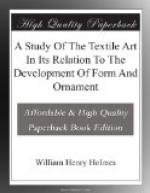The exact relations of the various classes of forces and phenomena pertaining to this theme may be more fully elucidated by the aid of illustrations. Woven mats, in early use by many tribes of men and originating in the attempt to combine leaves, vines, and branches for purposes of comfort, are flat because of function, the degree of flatness depending upon the size of filaments and mode of combination; and in outline they are irregular, square, round, or oval, as a result of many causes and influences, embracing use, construction, material, models, &c. A close approach to symmetry, where not imposed by some of the above mentioned agencies, is probably due to esthetic tendencies on the part of the artist. The esthetic interest attaching to such a shape cannot be great, unless perhaps it be regarded, as all individuals and classes may be regarded, in its possible relations to preceding, associated, and succeeding forms of art. The varied features observed upon the surface, the colors and patterns (Fig. 286), pertain to design rather than to form and will receive attention in the proper place.
[Illustration: Fig. 287. Tray having decided esthetic attributes of form. Obtained from the Apache—1/2.]
In point of contour the basket tray shown in Fig. 287 has a somewhat more decided claim upon esthetic attention than the preceding, as the curves exhibited mark a step of progress in complexity and grace. How much of this is due to intention and how much to technical perfection must remain in doubt. In work so perfect we are wont, however unwarrantably, to recognize the influence of taste.
[Illustration: Fig. 288. Pyriform water vessel used by the Piute Indians—1/8.]
A third example—presented in Fig. 288—illustrates an advanced stage in the art of basketry and exhibits a highly specialized shape. The forces and influences concerned in its evolution may be analyzed as follows: A primal origin in function and a final adaptation to a special function, the carrying and storing of water; a contour full to give capacity, narrow above for safety, and pointed below that it may be set in sand; curves kept within certain bounds by the limitations of construction; and a goodly share of variety, symmetry, and grace, the result to a certain undetermined extent of the esthetic tendencies of the artist’s mind. In regard to the last point there is generally in forms so simple an element of uncertainty; but many examples may be found in which there is positive evidence of the existence of a strong desire on the part of the primitive basketmaker to enhance beauty of form. It will be observed that the textile materials and construction do not lend themselves freely to minuteness in detail or to complexity of outline, especially in those small ways in which beauty is most readily expressed.




